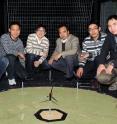Iowa State engineers study how hills, nearby turbines affect wind energy production
Hui Hu pulled a model wind turbine from the top of an office filing cabinet. The turbine tower was just 10 inches high. Its three blades were 10 inches in diameter. It was a perfect 1:320 scale reproduction of the 80-meter diameter wind turbines spinning across Iowa, the country's second-ranked state in installed wind power capacity. That mini turbine is helping a research team led by Hu, an Iowa State University associate professor of aerospace engineering, understand how hills, valleys and the placement of turbines affect the productivity of onshore wind farms.
While the wind industry has data about offshore turbine performance over flat water -- especially from European studies -- Hu said there's little data about the effects of uneven ground on wind turbines.
And so Hu and his research team have created the mini turbines and started running tests in Iowa State's $1.25 million Aerodynamic/Atmospheric Boundary Layer Wind and Gust Tunnel.
"We want to work with the wind turbine industry to transfer some of our findings," Hu said. "We can help boost total energy capture. And we can lengthen the lifetimes of wind turbines, making them more efficient."
The research team led by Hu includes Richard Wlezien, professor and Vance and Arlene Coffman Endowed Chair in Aerospace Engineering; Partha Sarkar, a professor of aerospace engineering, of civil, construction and environmental engineering, and director of Iowa State's Wind Simulation and Testing Laboratory; Zifeng Yang, a former Iowa State post-doctoral researcher and now an assistant professor at Wright State University in Dayton, Ohio; Wei Tian, a post-doctoral research associate in aerospace engineering; and Ahmet Ozbay, a graduate student in aerospace engineering.
The engineers' studies are supported by a three-year, $300,000 grant from the National Science Foundation and a two-year, $100,000 grant from the Iowa Alliance for Wind Innovation and Novel Development.
The researchers are using wind tunnel tests to quantify the characteristics of surface winds over hilly terrains, determine the best placement of wind turbines on hilly terrains and find the best design for large wind farms on hilly terrains.
Experiments include:
- Mini generators mounted inside the mini turbine nacelles measure power production
- Sensors mounted at the base of the mini turbines measure the wind loads placed on turbines and turbine towers
- Advanced flow measurements such as particle image velocimetry (which uses a laser and camera to take nearly simultaneous images that show the movement and velocity of individual particles) to measure wind flow fields, the wind vortices created by the tips of turbine blades and the total wind energy captured by the blades.
Hu said preliminary results indicate that wind turbines on hilly terrain are hit with much higher wind loads than turbines on flat terrain. The experiments also show that, compared with turbines on flat ground, wind flowing over hilly terrain recovers its power potential more rapidly as it moves from turbine to turbine.
Data from the wind tunnel indicate a turbine on flat ground in the wake of another turbine at a distance equal to six times the diameter of the turbines loses 13 percent of power production. A turbine in the wake of another with the same downstream distance on hilly ground loses 3 percent of power production.
"That means you can put wind turbines closer together in hilly terrain," he said.
In November, Hu, Yang and Sarkar published the first paper about their wind-turbine studies -- "Visualization of the tip vortices in a wind turbine wake" on the Journal of Visualization's website. The three researchers also presented findings of their turbine wake studies at the June 2011 Applied Aerodynamics Conference of the American Institute of Aeronautics and Astronautics.
The project's next steps include building a nine-turbine array in Iowa State's big wind tunnel to study power production and wind flows through a mini wind farm.
Hu is confident that data from the experiments can be valuable as more and more wind farms are built across Iowa and the country.
"These studies are telling us things we didn't know before," Hu said. "And this will help optimize the design of wind turbine layouts with consideration of the terrain."
Source: Iowa State University
Other sources
- Models test terrain effect on wind turbinefrom UPIWed, 14 Dec 2011, 4:30:23 UTC
- Models test terrain effect on wind turbinefrom UPIWed, 14 Dec 2011, 2:00:24 UTC
- Engineers study how hills, nearby turbines affect wind energy productionfrom Science DailyTue, 13 Dec 2011, 20:30:27 UTC
- Engineers Study How Hills, Nearby Turbines Affect Wind Energy Productionfrom Newswise - ScinewsTue, 13 Dec 2011, 19:00:33 UTC
- Iowa State engineers study how hills, nearby turbines affect wind energy productionfrom PhysorgTue, 13 Dec 2011, 18:00:58 UTC
- Wind farm fuels Ethiopia's green power ambitionsfrom PhysorgSun, 11 Dec 2011, 8:30:29 UTC
